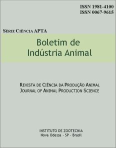Milk microbiological profile produced in a dairy farm from São Paulo State
Keywords:
milk quality, milking cows, S. aureus, StreptococcusAbstract
Milk is considered one of the finest food because its composition presents several important elements for human nutrition, but problems with animal health, such as mastitis, leads to the decrease in its production and quality. Mastitis is a bovine udder disease that has been the cause of low productivity and offers potential risk to the animal€™s health. Therefore, attention to the sanitary control of animals is very important. This study aimed to evaluate the milk microbiological quality of cows from a herd which is-composed of breed mixed /Jersey. Milk samples were collected fortnight in February and March of 2011, in 15 lactating cows that exhibited a herd€™s profile. Each collection totaled 60 samples and a total of 240 samples were obtained in the period. The samples were collected individually in sterile test tubes, previously identified with animal€™s name and number and mammary quarter. The teats were individually washed with water, dried with disposable paper and then dipped within antiseptic solution of iodine alcohol. The material was packed in insulated box material provided with ice cubes and taken to the laboratory for bacterial isolation and identification. The isolation and identification of strains were performed at Laboratory of the Milk Quality, in Instituto de Zootecnia. From 240 milk samples, 101 (42.08%) were infected and the microorganisms found and its prevalence are on table 1. The most prevalent organism was S. aureus, which one is quite worrying, because of its pathogenicity causing large variations in milk composition and somatics cells counts (SCC), reducing the functionality of the infected udder and being very contagious, leading to early disposal or death of the animal. Besides, toxins produced by S. aureus in milk foods may be responsible for causing food intoxication in humans. The second most frequent was Streptococcus spp., that is an important pathogen of contagious mastitis. The results showed presence of large population of bacteria such as S. aureus, Streptococcus, Corynebacterium spp. and indicated inadequate sanitary conditions of dairy cows; thus reinforcing the need for microbiological examination of milk samples, targeting specific measures that enable mastitis control in the herd.Downloads
Downloads
Published
Issue
Section
License
Os autores não serão remunerados pela publicação de trabalhos, pois devem abrir mão de seus direitos autorais em favor deste periódico. Por outro lado, os autores ficam autorizados a publicar seus artigos, simultaneamente, em repositórios da instituição de sua origem, desde que citada a fonte da publicação original seja Boletim de Indústria Animal. A revista se reserva o direito de efetuar, nos originais, alterações de ordem normativa, ortográfica e gramatical, com vistas a manter o padrão culto da língua e a credibilidade do veículo. Respeitará, no entanto, o estilo de escrever dos autores. Alterações, correções ou sugestões de ordem conceitual serão encaminhadas aos autores, quando necessário. Nesses casos, os artigos, depois de adequados, deverão ser submetidos a nova apreciação. As opiniões emitidas pelos autores dos artigos são de sua exclusiva responsabilidade. Todo o conteúdo deste periódico, exceto onde está identificado, está licenciado sob a Licença Creative Commons Attribution (CC-BY-NC). A condição BY implica que os licenciados podem copiar, distribuir, exibir e executar a obra e fazer trabalhos derivados com base em que só se dão o autor ou licenciante os créditos na forma especificada por estes. A cláusula NC significa que os licenciados podem copiar, distribuir, exibir e executar a obra e fazer trabalhos derivados com base apenas para fins não comerciais.













